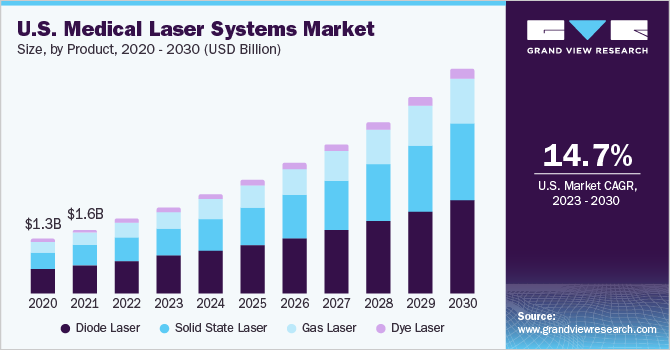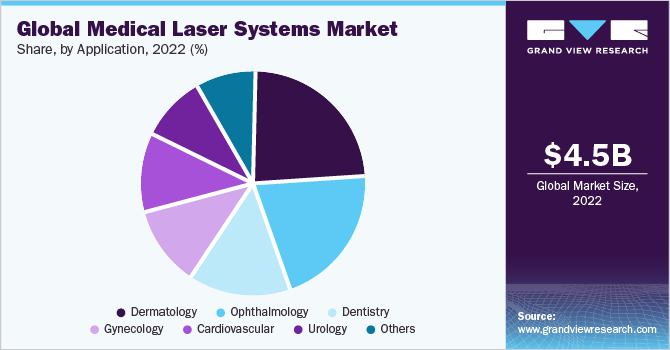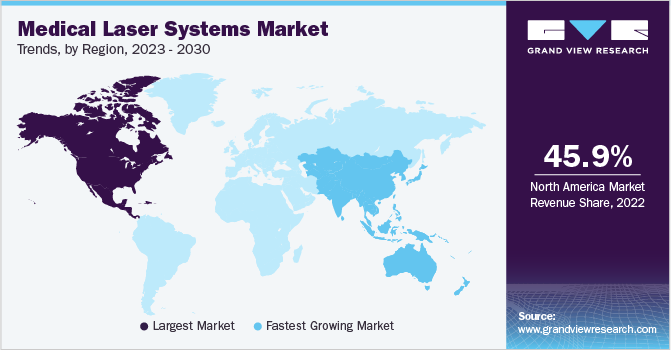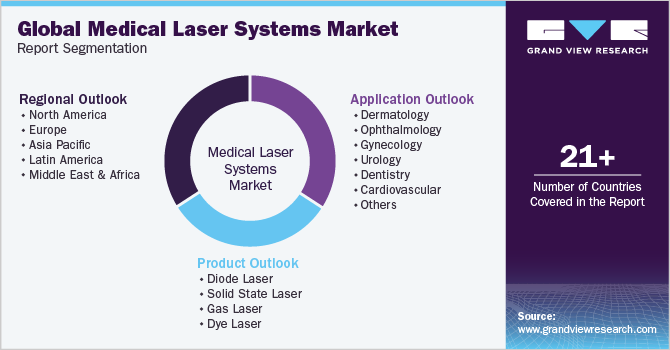- Home
- »
- Medical Devices
- »
-
Medical Laser Systems Market Size And Share Report, 2030GVR Report cover
![Medical Laser Systems Market Size, Share & Trends Report]()
Medical Laser Systems Market Size, Share & Trends Analysis Report By Product (Diode Lasers, Solid State Lasers, Gas Lasers), By Application (Dermatology, Ophthalmology, Gynecology, Dentistry, Urology), By Region, And Segment Forecasts, 2023 - 2030
- Report ID: 978-1-68038-574-8
- Number of Pages: 85
- Format: Electronic (PDF)
- Historical Range: 2018 - 2021
- Industry: Healthcare
Report Overview
The global medical laser systems market size was valued at USD 4.52 billion in 2022 and is expected to grow at a compound annual growth rate (CAGR) of 15.2% from 2023 to 2030. Various factors such as the increasing demand for advanced and minimally invasive treatment alternatives, significant technological advancements, increasing awareness among patients, and favorable reimbursement policies are anticipated to drive the growth. The expanding range of applications for medical lasers further increases the market's growth potential. A medical laser is a device that uses precisely focused light to diagnose biological problems and prevent their occurrence. Increasing demand for cosmetic treatments and the rising prevalence of chronic diseases are expected to drive growth over the forecast period.

The COVID-19 pandemic negatively impacted the medical laser system market. Healthcare facilities, such as hospitals and specialty clinics, were exhausted with COVID-19 patients; therefore, many healthcare institutions had to postpone surgeries and reschedule their plans of action for an indefinite period. In a few regions, minor hospitals and specialty clinics were shut down, while other hospitals were converted to housing facilities and treatment facilities for COVID-19 patients. The pandemic disrupted global supply chains, creating challenges in the production and distribution of laser systems. Restrictions on international trade, lockdown measures, and shortages of raw materials and components impacted the manufacturing and availability of devices. This adversely affected the industry, leading to delays in product launches and the overall supply of medical lasers.
During the pandemic, to minimize in-person visits and reduce the risk of transmission, remote consultations, and telemedicine became more prevalent. In some cases, dermatologists and other healthcare providers started using telemedicine to teach patients how to perform light amplification treatments at home with handheld devices available in the market. This resulted in a temporary shift in the market towards more portable and patient-centric laser systems.
Despite the challenges posed by the pandemic, research and development activities in the field continued. The focus shifted towards innovations such as contactless beam technologies, advancements in light radiation diagnostics, and the integration of light amplification with imaging and robotic concepts. The examiners from the National Institute of Standards and Technology (NIST) and CU Boulder have studied and demonstrated that a new laser-centered breathalyzer compelled by AI (artificial intelligence) can detect COVID-19 in real time with remarkable accuracy. These developments aimed to enhance patient safety, improve treatment outcomes, and expand the range of medical applications for lasers.
The increasing prevalence of chronic diseases, including cancer, cardiovascular disorders, and ophthalmic conditions, is increasing the demand for advanced therapeutic alternatives. Hence, medical lasers have emerged as valuable instruments due to their ability to deliver minimally invasive and precise procedures. Moreover, continuous advancements in laser technology have engendered the creation of more efficient and specialized medical laser systems. These innovations have resulted in enhanced treatment outcomes, reduced recovery periods, and widened the scope of procedures that can be accomplished through laser-based interventions.
There is a distinct trend among patients who are actively seeking less invasive treatment options, aimed at minimizing scarring, mitigating pain, and expediting the recovery process. Medical lasers have emerged as an effective solution, providing precise and targeted interventions that minimize damage to surrounding tissues. Additionally, the aging global population has led to a higher prevalence of age-related conditions, including cataracts, macular degeneration, and skin disorders. Consequently, the use of medical lasers in the treatment of these conditions has surged, thereby propelling the demand for laser systems.
Product Insights
Based on product, the market is segmented into diode lasers, solid state lasers, gas lasers, and dye lasers. The diode lasers segment dominated with the largest revenue share of 43.8% in 2022 owing to its varied application in aesthetic procedures and photodynamic treatment. Diode lasers first emerged in 1962 and are still the most energy-efficient and cost-effective lasers. These lasers are mostly preferred in the field of dermatology and dentistry segments as they are small in size and operate at lower power as compared to other optical masers in the industry.
The solid state lasers segment is expected to grow at the fastest CAGR of 15.9% during the forecast period due to high adoption rates in the field of dermatology. The solid-state system has been further categorized into Ho: YAG, Er: YAG, and Nd: YAG, and is widely applied in periodontology, tattoo removal, skin treatment, and vein removal treatment. The solid state laser systems segment is subject to regulatory oversight to ensure safety and efficacy. Different countries have their own regulatory bodies and approval processes for medical devices, including lasers.
Manufacturers are required to comply with relevant standards and obtain necessary approvals before commercializing their products. Factors contributing to the growth of these laser systems are the increasing demand for minimally invasive procedures, technological advancements in beam technology, the rising prevalence of chronic diseases, and the growing aging population.
Application Insights
The application segment is categorized into dermatology, ophthalmology, dentistry, gynecology, urology, cardiovascular, and others. The dermatology segment dominated the market with the largest revenue share of 24.2% in 2022. Some of the applications of medical lasers in the dermatology and aesthetics field include beam hair removal, tattoo removal, skin resurfacing, scar revision, fat reduction, age-related skin dysfunction, dermal contraction, vascular lesion treatment, and others. The other segments in this field include orthopedics, wound healing, biosensing, and general surgery.
The cardiovascular segment is expected to grow at the fastest CAGR of 17.7% over the forecast period from 2023 to 2030. This is attributed to the rising prevalence of heart diseases, age-related macular edema, coronary infarction, cardiac arrest, and artery diseases.

The ophthalmology segment help a significant revenue share in 2022. Medical laser systems are widely used for vision correction surgeries (LASIK, PRK) and treatment of various eye conditions such as glaucoma and diabetic retinopathy.
The gynecology segment is expected to grow at a lucrative CAGR over the forecast period from 2023 to 2030. Laser treatments also have applications in the gynecology field for treating issues related to fertility, vaginal condition, and radiation-assisted surgeries. They also help to remove kidney stone bladder tumors and prostate surgeries. Along with this, the system also finds applicability in the dentistry sector for soft tissue surgery, periodontal treatments, teeth whitening, and laser-assisted cavity detection.
Regional Insights
North America dominated the market and accounted for the largest revenue share of 45.9% in 2022. The region is characterized by advanced healthcare infrastructure, high healthcare expenditure, and a strong presence of key players such as Boston Scientific Corporation, Philips Healthcare, Stryker, IRIDEX Corporation, Bausch & Lomb Incorporated, and BIOLASE, Inc. The region shows a significant incidence of chronic diseases such as cancer, cardiovascular disorders, and diabetes. Medical lasers offer effective treatment options characterized by minimally invasive procedures, targeted therapy, and accelerated recovery times.
As the prevalence of chronic diseases continues to rise, the demand for medical laser systems in North America is expected to grow significantly. North America is a renowned hub for research and development, which has produced significant technological advancements in the field of medical lasers. This continuous pursuit of innovation has led to the creation of medical laser systems that offer enhanced efficiency, precision, and versatility.

Consequently, treatment outcomes have improved, and the scope of medical procedures that can be accomplished using lasers has expanded. The U.S., in particular, contributed significantly to the market growth due to its large population, technological advancements, and a high demand for aesthetic procedures. According to the National Library of Medicine, the U.S. invests more in healthcare services in comparison to other nations, on average it spends more than twice as much per person as The Organization for Economic Co-operation and Development (OECD) countries.
Asia Pacific is expected to witness the fastest CAGR of 16.7% during the forecast. Factors driving this growth include the increasing prevalence of chronic diseases, rising disposable incomes, growing awareness about aesthetic procedures, and the expanding healthcare infrastructure in countries such as China, Japan, South Korea, India, and Australia. This has helped in the development of new and innovative products and technologies in the region.
For instance, in April 2023, QinetiQ secured a contract worth USD 12.9 million for a partnership with the Department of Defence to jointly develop and manufacture a prototype of a high-energy defensive laser system in South Australia. Under this agreement, QinetiQ will partner with the Defence Science and Technology Group (DSTG) to establish a manufacturing capability specifically focused on high-energy lasers within the Australian region.
Key Companies & Market Share Insights
The rise in competition is leading to rapid technological advancements and companies are constantly working towards the improvement of their products with a major focus on research and development. Factors such as investment in research & development, compliance with regulatory policies, and technological advancements are constantly driving the introduction of novel techniques. Lumenis Be Ltd. is one of the leading global providers of light radiation and energy-based technologies. They offer a wide range of optical maser platforms for various medical specialties, including dermatology, aesthetics, urology, and ophthalmology.
For instance, in January 2020, Lumenis Be Ltd., a provider of energy-based medical devices for ophthalmic, surgical, and aesthetic applications, announced the launch of its LightSheer Quattro platform. The new addition to the LightSheer portfolio provides clinically validated laser hair removal treatments for all skin types. It offers two wavelength options of 805nm and 1060nm, ensuring versatility in addressing different patient needs. This advanced system ensures minimal downtime for patients. Moreover, it enables the treatment of pigmented and vascular lesions, expanding its applications beyond hair removal. The system incorporates innovative features such as high-speed vacuum-assisted technology and ChillTip-integrated contact cooling technology. By combining these technologies, it allows practitioners to deliver superior clinical outcomes. Patients can benefit from comfortable, effective, fast, and safe treatment experiences. Some prominent players in the global medical laser systems market include:
-
Lumenix
-
Photomedex
-
Philips Healthcare
-
BIOLASE, Inc.
-
IRIDEX Corporation
-
BioForm Medical, Inc.
-
biolitec AG
-
Cutera
-
Candela Corporation
-
Cynosure
Medical Laser Systems Market Report Scope
Report Attribute
Details
Market size value in 2023
USD 5.21 billion
Revenue forecast 2030
USD 14.0 billion
Growth rate
CAGR of 15.2% from 2023 to 2030
Base year for estimation
2022
Historical data
2018 - 2021
Forecast period
2023 - 2030
Report updated
September 2023
Quantitative units
Revenue in USD million/billion and CAGR from 2023 to 2030
Report coverage
Revenue forecast, company ranking, competitive landscape, growth factors, and trends
Segments covered
Product, application, region
Regional scope
North America; Europe; Asia Pacific; Latin America; MEA
Country scope
U.S.; Canada; U.K.; Germany; France; Italy; Spain; Denmark; Sweden; Norway; Japan; China; India; Australia; South Korea; Thailand; Brazil; Mexico; Argentina; Saudi Arabia; South Africa; UAE; Kuwait
Key companies profiled
Lumenix; Photomedex; Philips Healthcare; BIOLASE, Inc.; IRIDEX Corporation; BioForm Medical, Inc.; biolitec AG; Cutera; Candela Corporation; Cynosure
Customization scope
Free report customization (equivalent up to 8 analyst’s working days) with purchase. Addition or alteration to country, regional & segment scope
Pricing and purchase options
Avail customized purchase options to meet your exact research needs. Explore purchase options
Global Medical Laser Systems Market Report Segmentation
This report forecasts revenue growth at global, regional, and country levels and analyzes the latest industry trends in each sub-segment from 2018 to 2030. For this study, Grand View Research has segmented the global medical laser systems marketreport based on product, application, and region:

-
Product Outlook (Revenue, USD Million, 2018 - 2030)
-
Diode Laser
-
Solid State Laser
-
Holmium Yttrium Aluminum Garnet (Ho:Yag) lasers
-
Erbium Yttrium Aluminum Garnet (Er:Yag) lasers
-
Neodynium Yttrium Aluminum Garnet (Nd:Yag) lasers
-
Potassium Titanyl Phosphate (KTP)
-
Alexandrite lasers
-
Ruby lasers
-
-
Gas Laser
-
Co2 Laser
-
Argon Laser
-
Krypton Laser
-
Metal Vapor (Au & Cu) Laser
-
Helium-Neon Laser
-
Excimer Laser
-
-
Dye Laser
-
-
Application Outlook (Revenue, USD Million, 2018 - 2030)
-
Dermatology
-
Ophthalmology
-
Gynecology
-
Urology
-
Dentistry
-
Cardiovascular
-
Others (Gastroenterology, Rheumatology, Traumatology)
-
-
Regional Outlook (Revenue, USD Million, 2018 - 2030)
-
North America
-
U.S.
-
Canada
-
-
Europe
-
UK
-
Germany
-
France
-
Italy
-
Spain
-
Denmark
-
Sweden
-
Norway
-
-
Asia Pacific
-
Japan
-
China
-
India
-
Australia
-
Thailand
-
South Korea
-
-
Latin America
-
Brazil
-
Mexico
-
Argentina
-
-
Middle East & Africa
-
South Africa
-
Saudi Arabia
-
UAE
-
Kuwait
-
-
Frequently Asked Questions About This Report
b. The global medical laser systems market size was estimated at USD 4.52 billion in 2022 and is expected to reach USD 5.21 billion in 2023.
b. The global medical laser systems market is expected to grow at a compound annual growth rate of 15.2% from 2023 to 2030 to reach USD 14.0 billion by 2030.
b. North America dominated the medical laser systems market with a share of 45.9% in 2022. This is attributable to the rising adoption of cosmetic lift-ups and increasing demand for aesthetic surgeries along with high disposable income and increasing healthcare spending by patients.
b. Some of the key players operating in the medical laser systems market include Photomedex Inc, Lumenis Ltd, Biolase Inc, Spectranetics Corporation, and IRIDEX Corporation.
b. Key factors that are driving the market growth include increasing demand for noninvasive cosmetic surgeries, growing awareness about the safety of these procedures, and technological advancements.
Share this report with your colleague or friend.
![gvr icn]()
NEED A CUSTOM REPORT?
We can customize every report - free of charge - including purchasing stand-alone sections or country-level reports, as well as offer affordable discounts for start-ups & universities. Contact us now
![Certified Icon]()
We are GDPR and CCPA compliant! Your transaction & personal information is safe and secure. For more details, please read our privacy policy.
We are committed towards customer satisfaction, and quality service.
"The quality of research they have done for us has been excellent."





